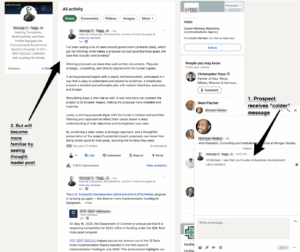When it comes to B2B LinkedIn lead generation, LinkedIn isn’t just another social network, it’s the place where business happens. The platform brings together decision-makers from virtually every industry and company size, making it a goldmine for building relationships that lead to real revenue.
That said, turning connections into customers takes more than just showing up. Success on LinkedIn often hinges on your approach and most strategies fall into one of two buckets: push or pull marketing.
In this post, we’ll touch on what each approach really means, when to use them in your LinkedIn lead gen strategy, and how the most effective companies are combining both to grow faster and smarter. Plus, we’ll share how one consulting firm did exactly that to boost both credibility and conversions.
Understanding Push and Pull Marketing on LinkedIn
Push marketing is about initiating contact. It includes things like direct outreach via connection requests, InMails, and personalized messages. It’s proactive, targeted, and designed to get your offer or value proposition in front of the right people quickly.
Pull marketing, on the other hand, takes a slower, more organic path. It centers on creating content, whether that’s thought leadership posts, LinkedIn articles, or company page updates, that builds visibility and trust over time. Rather than reaching out directly, you’re drawing people in by consistently sharing insights that speak to their needs.
The Benefits and Tradeoffs of Each Approach
Both push vs pull marketing have their strengths and their limitations.
Push marketing (also known as outbound marketing) gives you a fast feedback loop. You can test messaging, identify interested prospects quickly, and scale your outreach with tools like LinkedIn Sales Navigator or automation platforms. LinkedIn outbound marketing is especially useful for startups or sales teams looking to fill their pipeline fast. But without the right messaging and targeting, it can backfire, leading to low response rates or even harming your brand if it feels too aggressive or impersonal.
Pull marketing (also known as inbound marketing), by contrast, builds long-term credibility. The leads you attract tend to be warmer, since they’ve already seen your content and come to you with interest. LinkedIn inbound marketing is ideal for establishing authority in your niche and scaling your brand presence over time. That said, it requires consistency and patience and it’s harder to control the volume or timing of inbound leads.
When to Use Push, Pull, or Both
The right approach often depends on where you are in your growth journey.
If you’re in an early stage or launching something new, push marketing can help you gain momentum quickly. It gets your message out in front of the right people while you’re still building up your organic presence. For more established brands, pull marketing becomes a powerful tool to reinforce your credibility, attract inbound leads, and stay top of mind.
But the truth is, you don’t have to choose. The most effective LinkedIn marketing strategies use both, layering consistent, high-value content with smart, targeted outreach. This combination creates a prosperous cycle: your content warms up your audience, making outreach more effective, while conversations from outreach drive more visibility to your content.
Push & Pull in Action: How a Federal Grant Consulting Firm Blended Push and Pull
A federal grant consulting firm specializing in guiding organizations through complex application processes set out to accomplish two key goals: generate qualified leads quickly and establish itself as a trusted expert in a niche, highly technical space.
To create immediate traction, we launched a targeted LinkedIn messaging campaign aimed at decision-makers. These personalized messages highlighted the firm’s unique expertise and value, sparking one-on-one conversations with ideal prospects.
At the same time, they maintained a consistent stream of thought leadership content—sharing insights on federal funding trends, practical tips to boost grant success rates, and behind-the-scenes highlights of client wins.
We crafted social posts that positioned the Founder as a credible thought leader in the space, highlighting their expertise, insights, and unique perspective. This approach built familiarity and trust, so when outreach messages landed, they felt more like a warm introduction than a cold pitch.
Over time, this dual strategy created a compounding effect. The content generated visibility and trust, while the outbound messaging brought in high-fit leads already primed to engage. The result: more conversations, stronger authority, and measurable growth in pipeline.

Final Thoughts: Why Pick One When You Can Have Both?
Here’s the truth: you don’t have to pick sides. Push marketing gets you in the room. Pull marketing makes sure people know your name before you walk through the door.
When you combine both, you’re not just generating leads, you’re building relationships, authority, and momentum.
So if your LinkedIn strategy feels a little one-sided (or just a little stale), it might be time for a tune-up. Mix in more content if you’re always in outreach mode. Add some targeted messages if you’re only posting and hoping.
The magic happens when both strategies work together and that’s when LinkedIn stops feeling like a chore and starts driving real results.